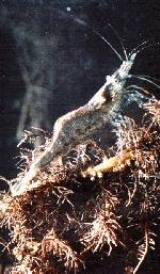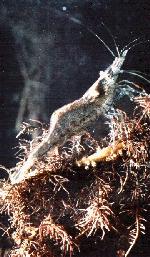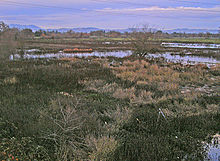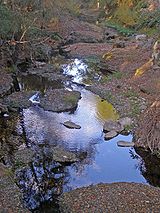
Syncaris pacifica
Encyclopedia
Syncaris pacifica is an endangered species
Endangered species
An endangered species is a population of organisms which is at risk of becoming extinct because it is either few in numbers, or threatened by changing environmental or predation parameters...
of freshwater
Fresh Water
Fresh Water is the debut album by Australian rock and blues singer Alison McCallum, released in 1972. Rare for an Australian artist at the time, it came in a gatefold sleeve...
shrimp
Shrimp
Shrimp are swimming, decapod crustaceans classified in the infraorder Caridea, found widely around the world in both fresh and salt water. Adult shrimp are filter feeding benthic animals living close to the bottom. They can live in schools and can swim rapidly backwards. Shrimp are an important...
in the family Atyidae
Atyidae
Atyidae is a family of shrimp, present in all tropical and most temperate waters of the world. Adults of this family are almost always confined to fresh water...
that occurs only in a limited range
Range (biology)
In biology, the range or distribution of a species is the geographical area within which that species can be found. Within that range, dispersion is variation in local density.The term is often qualified:...
within the northern San Francisco Bay Area
San Francisco Bay Area
The San Francisco Bay Area, commonly known as the Bay Area, is a populated region that surrounds the San Francisco and San Pablo estuaries in Northern California. The region encompasses metropolitan areas of San Francisco, Oakland, and San Jose, along with smaller urban and rural areas...
, California
California
California is a state located on the West Coast of the United States. It is by far the most populous U.S. state, and the third-largest by land area...
, USA
United States
The United States of America is a federal constitutional republic comprising fifty states and a federal district...
. Specifically, this species
Species
In biology, a species is one of the basic units of biological classification and a taxonomic rank. A species is often defined as a group of organisms capable of interbreeding and producing fertile offspring. While in many cases this definition is adequate, more precise or differing measures are...
occurs only in 17 stream
Stream
A stream is a body of water with a current, confined within a bed and stream banks. Depending on its locale or certain characteristics, a stream may be referred to as a branch, brook, beck, burn, creek, "crick", gill , kill, lick, rill, river, syke, bayou, rivulet, streamage, wash, run or...
segments within Sonoma
Sonoma County, California
Sonoma County, located on the northern coast of the U.S. state of California, is the largest and northernmost of the nine San Francisco Bay Area counties. Its population at the 2010 census was 483,878. Its largest city and county seat is Santa Rosa....
, Napa
Napa County, California
Napa County is a county located north of the San Francisco Bay Area in the U.S. state of California. It is coterminous with the Napa, California, Metropolitan Statistical Area. As of 2010 the population is 136,484. The county seat is Napa....
and Marin Counties
Marin County, California
Marin County is a county located in the North San Francisco Bay Area of the U.S. state of California, across the Golden Gate Bridge from San Francisco. As of 2010, the population was 252,409. The county seat is San Rafael and the largest employer is the county government. Marin County is well...
. This species is often translucent to transparent, with both sex
Sex
In biology, sex is a process of combining and mixing genetic traits, often resulting in the specialization of organisms into a male or female variety . Sexual reproduction involves combining specialized cells to form offspring that inherit traits from both parents...
es capable of considerable color
Color
Color or colour is the visual perceptual property corresponding in humans to the categories called red, green, blue and others. Color derives from the spectrum of light interacting in the eye with the spectral sensitivities of the light receptors...
ation altering, as a sophisticated form of camouflage
Camouflage
Camouflage is a method of concealment that allows an otherwise visible animal, military vehicle, or other object to remain unnoticed, by blending with its environment. Examples include a leopard's spotted coat, the battledress of a modern soldier and a leaf-mimic butterfly...
. This decapod
Decapoda
The decapods or Decapoda are an order of crustaceans within the class Malacostraca, including many familiar groups, such as crayfish, crabs, lobsters, prawns and shrimp. Most decapods are scavengers. It is estimated that the order contains nearly 15,000 species in around 2,700 genera, with...
is commonly known as California freshwater shrimp, and is the only decopod shrimp in California that occurs in non-saline water
Saline water
Saline water is a general term for water that contains a significant concentration of dissolved salts . The concentration is usually expressed in parts per million of salt....
s.
S. pacifica is one of only four members of the family Atyidae in North America
North America
North America is a continent wholly within the Northern Hemisphere and almost wholly within the Western Hemisphere. It is also considered a northern subcontinent of the Americas...
. Genetic
Genetics
Genetics , a discipline of biology, is the science of genes, heredity, and variation in living organisms....
studies have been conducted to compare specimens of Syncaris pacifica from various drainages, with the results showing a variety of well-defined genetic variations within these populations. The species has a superficial appearance to its better known marine relatives, and may attain a body length of about 5 cm.
Morphology

Crustacean
Crustaceans form a very large group of arthropods, usually treated as a subphylum, which includes such familiar animals as crabs, lobsters, crayfish, shrimp, krill and barnacles. The 50,000 described species range in size from Stygotantulus stocki at , to the Japanese spider crab with a leg span...
that employs a two-pronged approach to camouflage
Camouflage
Camouflage is a method of concealment that allows an otherwise visible animal, military vehicle, or other object to remain unnoticed, by blending with its environment. Examples include a leopard's spotted coat, the battledress of a modern soldier and a leaf-mimic butterfly...
: it uses a technique of translucency coupled with strategically placed chromatophore
Chromatophore
Chromatophores are pigment-containing and light-reflecting cells found in amphibians, fish, reptiles, crustaceans, and cephalopods. They are largely responsible for generating skin and eye colour in cold-blooded animals and are generated in the neural crest during embryonic development...
s, which occur internally as well as on the surface. As a result, the clustered color-producing cells combined with translucency masks the body outline and blends the organism
Organism
In biology, an organism is any contiguous living system . In at least some form, all organisms are capable of response to stimuli, reproduction, growth and development, and maintenance of homoeostasis as a stable whole.An organism may either be unicellular or, as in the case of humans, comprise...
to its subsurface environment. Consequently an illusion is presented that S. pacifica are submerged, decaying vegetation
Vegetation
Vegetation is a general term for the plant life of a region; it refers to the ground cover provided by plants. It is a general term, without specific reference to particular taxa, life forms, structure, spatial extent, or any other specific botanical or geographic characteristics. It is broader...
. California freshwater shrimp move quite torpidly and are practically invisible among water column leaf and twig substrates, and among the slender, exposed, living roots of riparian vegetation
Vegetation
Vegetation is a general term for the plant life of a region; it refers to the ground cover provided by plants. It is a general term, without specific reference to particular taxa, life forms, structure, spatial extent, or any other specific botanical or geographic characteristics. It is broader...
along undercut stream banks.
Males and juveniles are always translucent or transparent, while coloration of the sometimes translucent females ranges from dark brown to purple, some with a broad tan dorsal
Dorsum (biology)
In anatomy, the dorsum is the upper side of animals that typically run, fly, or swim in a horizontal position, and the back side of animals that walk upright. In vertebrates the dorsum contains the backbone. The term dorsal refers to anatomical structures that are either situated toward or grow...
band. Females may change rapidly from this very dark cryptic color
Crypsis
In ecology, crypsis is the ability of an organism to avoid observation or detection by other organisms. It may be either a predation strategy or an antipredator adaptation, and methods include camouflage, nocturnality, subterranean lifestyle, transparency, and mimicry...
to nearly transparent with diffuse chromatophores. Moreover, females are typically longer and deeper bodied than males.
All Atyidae family members can be distinguished from other shrimp by their overall length as well as the extent length of their pincer-like claws and manifestation of terminal bristles (setae) at the tips of the first and second chelae
Chela (organ)
A chela is a pincer-like organ terminating certain limbs of some arthropods. The name comes from Greek through New Latin . The plural form is chelae. Legs bearing a chela are called chelipeds. Another name is claw because most chelae are curved and have a sharp point like a claw....
. A short spine above the eye and the angled articulation of the second chelae with the carpus
Carpus
In tetrapods, the carpus is the sole cluster of bones in the wrist between the radius and ulna and the metacarpus. The bones of the carpus do not belong to individual fingers , whereas those of the metacarpus do. The corresponding part of the foot is the tarsus...
differentiate the California freshwater shrimp from other shrimp that occur California. A carapace
Carapace
A carapace is a dorsal section of the exoskeleton or shell in a number of animal groups, including arthropods such as crustaceans and arachnids, as well as vertebrates such as turtles and tortoises. In turtles and tortoises, the underside is called the plastron.-Crustaceans:In crustaceans, the...
length (reckoned from eye socket to tail-tip) of slightly more than five centimeters can be attained.
Range

Quaternary
The Quaternary Period is the most recent of the three periods of the Cenozoic Era in the geologic time scale of the ICS. It follows the Neogene Period, spanning 2.588 ± 0.005 million years ago to the present...
have significantly altered river courses of the Northern California
Northern California
Northern California is the northern portion of the U.S. state of California. The San Francisco Bay Area , and Sacramento as well as its metropolitan area are the main population centers...
coast. Historically, Syncaris pacifica may have occurred as far north as the Klamath River
Klamath River
The Klamath River is an American river that flows southwest through Oregon and northern California, cutting through the Cascade Range to empty into the Pacific Ocean. The river drains an extensive watershed of almost that stretches from the high desert country of the Great Basin to the temperate...
, but reductions of habitat
Habitat
* Habitat , a place where a species lives and grows*Human habitat, a place where humans live, work or play** Space habitat, a space station intended as a permanent settlement...
, especially from overgrazing
Overgrazing
Overgrazing occurs when plants are exposed to intensive grazing for extended periods of time, or without sufficient recovery periods. It can be caused by either livestock in poorly managed agricultural applications, or by overpopulations of native or non-native wild animals.Overgrazing reduces the...
of cattle, along with chemical water pollution
Water pollution
Water pollution is the contamination of water bodies . Water pollution occurs when pollutants are discharged directly or indirectly into water bodies without adequate treatment to remove harmful compounds....
has greatly diminished the present range to 17 stream segments in Sonoma, Napa and Marin Counties. These habitat stream segments are sometimes separated by degraded portions of a given creek, effectively leading to a fragmented population
Habitat fragmentation
Habitat fragmentation as the name implies, describes the emergence of discontinuities in an organism's preferred environment , causing population fragmentation...
. Occurrence is restricted to perennial
Perennial stream
A perennial stream or perennial river is a stream or river that has continuous flow in parts of its bed all year round during years of normal rainfall. "Perennial" streams are contrasted with "intermittent" streams which normally cease flowing for weeks or months each year, and with "ephemeral"...
streams below 100 meters above sea level in elevation and of gradient less than one percent. The stream segments can be grouped as follows:
- Certain stream segments which drain directly to the Pacific OceanPacific OceanThe Pacific Ocean is the largest of the Earth's oceanic divisions. It extends from the Arctic in the north to the Southern Ocean in the south, bounded by Asia and Australia in the west, and the Americas in the east.At 165.2 million square kilometres in area, this largest division of the World...
, including Tomales BayTomales BayTomales Bay is a long narrow inlet of the Pacific Ocean in Marin County in northern California in the United States. It is approximately 15 miles long and averages nearly 1.0 miles wide, effectively separating the Point Reyes Peninsula from the mainland of Marin County. It is located...
, in Marin and Sonoma Counties - Sonoma CreekSonoma CreekSonoma Creek is a stream in northern California. It is one of two principal drainages of southern Sonoma County, California, with headwaters rising in the rugged hills of Sugarloaf Ridge State Park and discharging to San Pablo Bay, the northern arm of San Francisco Bay. The watershed drained by...
, lower Napa RiverNapa RiverThe Napa River, approximately 55 miles long, is a river in the U.S. state of California. It drains a famous wine-growing region, called the Napa Valley, in the mountains northeast of San Francisco. Milliken Creek is a tributary of the Napa River....
, Tolay CreekTolay CreekTolay Creek is a southward-flowing stream in southern Sonoma County, California, USA, which flows through Tolay Lake and ends in north San Pablo Bay.-History:The Alaguali were a Coast Miwok community of northern San Pablo Bay in the Tolay Creek region...
and Petaluma RiverPetaluma RiverThe Petaluma River is a river in the California counties of Sonoma and Marin that becomes a tidal slough near its mouth. It springs from farmlands southwest of Cotati and flows generally southward through Petaluma's old town and of tidal marshes to end in northwest San Pablo Bay.-History:The word...
, all of which drain to the San Pablo BaySan Pablo BaySan Pablo Bay is a tidal estuary that forms the northern extension of San Francisco Bay in northern California in the United States. Most of the Bay is shallow; however, there is a deep water channel approximately in mid bay, which allows access to Sacramento, Stockton, Benicia, Martinez, and... - Certain lower tributaries of the Russian RiverRussian River (California)The Russian River, a southward-flowing river, drains of Sonoma and Mendocino counties in Northern California. With an annual average discharge of approximately , it is the second largest river flowing through the nine county Greater San Francisco Bay Area with a mainstem 110 miles ...
including the Laguna de Santa RosaLaguna de Santa RosaThe Laguna de Santa Rosa is a long wetland complex that drains a 254-square mile watershed encompassing most of the Santa Rosa Plain in Sonoma County, California, USA.-Description:...
and certain of its tributaries such as Blucher CreekBlucher CreekBlucher Creek is a stream that rises in the hills south of Sebastopol, California, United States, and empties into the Laguna de Santa Rosa.-Course:...
Habitat and behavior

Precipitation (meteorology)
In meteorology, precipitation In meteorology, precipitation In meteorology, precipitation (also known as one of the classes of hydrometeors, which are atmospheric water phenomena is any product of the condensation of atmospheric water vapor that falls under gravity. The main forms of precipitation...
and surface runoff
Surface runoff
Surface runoff is the water flow that occurs when soil is infiltrated to full capacity and excess water from rain, meltwater, or other sources flows over the land. This is a major component of the water cycle. Runoff that occurs on surfaces before reaching a channel is also called a nonpoint source...
the flow rates can be very low with larger pools but they characteristically transport heavy runoff during the rainy winter season.
As a slow moving species S. pacifica feeds on decomposing vegetation and other detritus, consuming minute diverse particles conveyed by currents to downstream pools. As the water slows, the particles are filtered by the fine network of exposed roots from trees, such as from willows and alders. The California freshwater shrimp merely brush up the food with tufts at the tips of their small claw
Claw
A claw is a curved, pointed appendage, found at the end of a toe or finger in most mammals, birds, and some reptiles. However, the word "claw" is also often used in reference to an invertebrate. Somewhat similar fine hooked structures are found in arthropods such as beetles and spiders, at the end...
s, and lift to their mouths the collected morsels. Colonized by algae, bacteria
Bacteria
Bacteria are a large domain of prokaryotic microorganisms. Typically a few micrometres in length, bacteria have a wide range of shapes, ranging from spheres to rods and spirals...
, fungi, and microscopic animals, the particle agglomerates are quite nutritious. Although most species of shrimp walk slowly about the roots as they feed, S. pacitica will undertake short swimming bursts to obtain particularly desirable items.
Breeding occurs once per annum during the autumn. Adults attain sexually maturity by the end of their second summer. A female can be expected to generate approximately 50 to 120 eggs per breeding season, which remain attached to the mother for the entire winter. Studies on other family members suggest a lifespan for this species of several years.
Conservation
Syncaris pacifica and associated native aquatic species- Protect and manage S. pacifica populations and habitat once the threats are removed and restorationRestoration ecology-Definition:Restoration ecology is the scientific study and practice of renewing and restoring degraded, damaged, or destroyed ecosystems and habitats in the environment by active human intervention and action, within a short time frame...
has been completed - Monitor and evaluate S. pacifica habitat conditions and populations
- Assess effectiveness of various conservationConservation biologyConservation biology is the scientific study of the nature and status of Earth's biodiversity with the aim of protecting species, their habitats, and ecosystems from excessive rates of extinction...
efforts - Conduct research on the biologyBiologyBiology is a natural science concerned with the study of life and living organisms, including their structure, function, growth, origin, evolution, distribution, and taxonomy. Biology is a vast subject containing many subdivisions, topics, and disciplines...
of the species - Restore and maintain viable S. pacifica populations at extirpated locations
- Increase public awareness and involvement in the protection of S. pacifica and native cohabiting species
- Assess effects of various conservation efforts on cohabiting native species
- Assemble a S. pacifica recovery team
There are individual efforts occurring in various stream segments, one of the most notable being a grassroots
Grassroots
A grassroots movement is one driven by the politics of a community. The term implies that the creation of the movement and the group supporting it are natural and spontaneous, highlighting the differences between this and a movement that is orchestrated by traditional power structures...
conservation program
Conservation biology
Conservation biology is the scientific study of the nature and status of Earth's biodiversity with the aim of protecting species, their habitats, and ecosystems from excessive rates of extinction...
to restore over 1400 metres (4,593.2 ft) of Stemple Creek
Stemple Creek
Stemple Creek is a long, westward-flowing stream in the California counties of Sonoma and Marin, which feeds into the Estero de San Antonio. Its waters ultimately reach Bodega Bay, part of the Gulf of the Farallones National Marine Sanctuary on the Pacific Ocean.-Course:Stemple Creek springs from...
by students at Brookside School in Marin County
Marin County, California
Marin County is a county located in the North San Francisco Bay Area of the U.S. state of California, across the Golden Gate Bridge from San Francisco. As of 2010, the population was 252,409. The county seat is San Rafael and the largest employer is the county government. Marin County is well...
. In this case students raised money, lobbied legislators and succeeded in obtaining grant funds to prevent cattle grazing within the creek, one of the greatest habitat threats.
Although a new location of Syncaris pacifica was found in the 1990s at Olema Creek, the general trend for the population of this organism is decline. For example, 1999 surveys in Marin County found fewer individuals present than a comparable 1997 survey.

